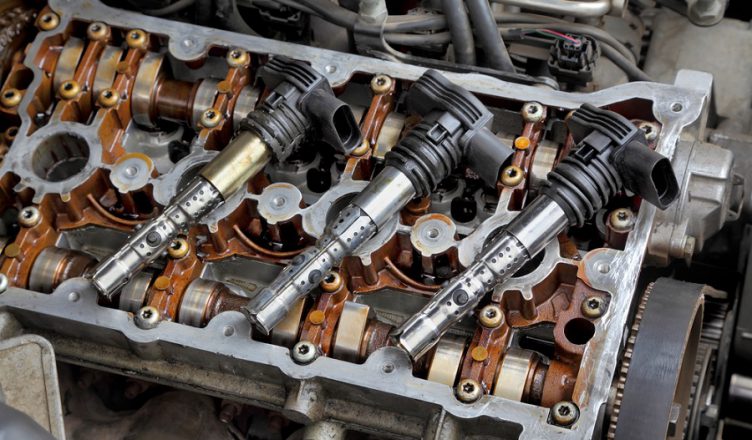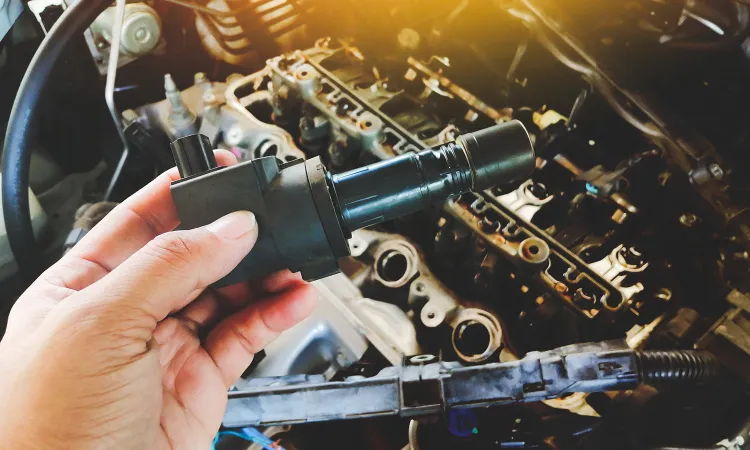The functioning of a vehicle’s ignition system is paramount to its overall performance, playing a pivotal role in the conversion of fuel into the energy required for movement. At the heart of this intricate system lies a small yet crucial component:the ignition coil. Without electricity, the engine stands still, unable to initiate the combustion process that propels the vehicle forward. In this blog post, we delve into the depths of the ignition coil, exploring its construction, understanding the symptoms indicating potential damage, and elucidating methods to effectively check its operational health.
- Significance of the Ignition System:
- The ignition system is the lifeblood of a vehicle, facilitating the transformation of fuel into kinetic energy.
- A malfunctioning ignition system directly hampers the engine’s ability to operate efficiently.
- Role of the Ignition Coil:
- The ignition coil emerges as a key player in this system, serving as the conduit for electrical energy transmission.
- This blog focuses on unraveling the mysteries of the ignition coil, shedding light on its structure, operation, and critical role in vehicular functionality.
- Overview :
- A brief overview of what readers can expect from the subsequent sections, including insights into the construction and operation of the ignition coil,
- I promise to guide readers through recognizing symptoms of damage and providing practical steps to check the ignition coil for potential issues.
As we embark on this journey into the intricacies of the ignition coil, readers will gain a comprehensive understanding of its significance, enabling them to better appreciate the inner workings of their vehicle’s engine.
Ignition Coil Structure and Operation
The ignition coil, a pivotal component within a vehicle’s ignition system, boasts a multifaceted structure designed to convert low-voltage current into a substantially higher voltage, reaching up to an impressive 30,000 volts. At its core, the ignition coil consists of two crucial elements: the primary and secondary coils, both integral to the energy accumulation process. The primary coils, thicker but smaller, possess a positive charge and are responsible for collecting electricity. In contrast, the secondary coil, comprised of significantly thinner wire with a negative charge, plays a role in amplifying the voltage. This coil assembly is tightly wound around a core of metal plates, shielded by specialized insulation, and enclosed within a protective plastic housing.
The operation of the ignition coil unfolds through a sequence of transformations. As the current enters the winding, it accumulates and morphs into a magnetic field. Subsequently, this field collapses, inducing an induction current by closing the circuit. The journey then proceeds to the secondary coil, where the tension amplifies. Through a precisely controlled interruption of the circuit, a substantial current is released, finding its way to the spark plug via a high-voltage contact. This orchestrated process culminates in the generation of a spark, initiating the combustion process crucial for the engine’s functionality.
- Primary and Secondary Coils: thinner primary coils with a positive charge for electricity collection, and thinner secondary coils with a negative charge for voltage amplification.
- Core and Insulation: Tight core of metal plates covered with specialized insulation ensures efficient functioning and protection.
- Plastic Housing: The entire mechanism is enclosed within a plastic housing, safeguarding it from external elements and ensuring user safety.
- Sequence of Transformations: Current accumulation, magnetic field formation, induction current generation, and controlled circuit interruption contribute to the production of a spark for combustion.
Understanding the intricate structure and orchestrated operation of the ignition coil is fundamental to appreciating its vital role in the engine’s ignition system. This knowledge forms the basis for diagnosing potential issues and ensuring the overall efficiency of the vehicle.
Symptoms of Ignition Coil Damage
The ignition coil, while essential for the vehicle’s electrical system, can exhibit various symptoms when it is damaged. Recognizing these signs is crucial for timely intervention and preventing further issues.
A. Overview of Common Indicators
- Fluctuating Engine Speeds: One prominent symptom of a damaged ignition coil is irregular engine speeds. Drivers may notice unexpected surges or drops in RPM (revolutions per minute) during acceleration or while the vehicle is idling.
- Jerking during Acceleration or Idle: Damaged ignition coils can lead to erratic engine behavior, causing noticeable jerking sensations when accelerating or maintaining a steady idle. This indicates disruptions in the combustion process.
B. Increased Fuel Consumption and Starting Issues
- Higher Fuel Consumption: A faulty ignition coil can result in inefficient combustion, leading to increased fuel consumption. Drivers might observe a decrease in fuel efficiency, prompting the need for investigation.
- Starting Problems: Difficulty starting the vehicle is a common red flag. If the ignition coil fails to provide a spark to initiate combustion, the engine may struggle to turn over, especially in challenging conditions like high humidity.
C. Specific Scenarios
- High Humidity Challenges: Some drivers experience ignition issues, particularly during high humidity conditions such as rain or snow. When the coil fails to transmit the spark to the spark plug, moisture becomes a conductor, hindering proper engine ignition.
D. Additional Symptoms
- Check Engine Light: A lit check engine light on the dashboard is a general indicator of potential issues within the vehicle. Ignition coil problems may trigger this warning, prompting further diagnostic checks.
- Cylinder Misfires: Damaged coils can lead to misfires in specific engine cylinders, affecting overall performance. This can result in rough idling, reduced power, and potential damage to the catalytic converter.
- Cold Engine Problems: Ignition coil issues may manifest prominently when the engine is cold. Difficulties in starting or poor engine performance during these conditions are indicative of potential coil damage.
In conclusion, being vigilant for these symptoms allows drivers to address ignition coil problems promptly. Regular checks and immediate attention to these warning signs contribute to the overall health and efficiency of the vehicle’s ignition system.

How to Check the Ignition Coil
The process of checking the ignition coil involves using an ohmmeter, a vital tool for assessing the coil’s resistance and diagnosing potential issues. Below is a step-by-step guide on how to perform this check:
- Importance of Ohmmeter Diagnosis:
- An ohmmeter is a valuable diagnostic tool that helps measure the electrical resistance of the ignition coil.
- This measurement aids in understanding how the coil absorbs and processes current, offering insights into its health.
- Step-by-Step Guide:
- Prepare the ohmmeter: Begin by setting the ohmmeter to the appropriate scale, ensuring it aligns with the coil’s resistance range.
- Connect the ohmmeter to the coil.
- Link the ohmmeter to the ignition coil by connecting its probes to the respective terminals on the coil.
- Take note of the specific connection points, as improper connections may yield inaccurate readings.
- Check resistance values:
- Refer to the car’s manual or the coil’s specifications to determine the correct resistance values.
- Compare the measured resistance with the recommended range; discrepancies may indicate potential issues.
- Interpretation of Results:
- If the measured values fall within the specified range, the ignition coil is likely functioning correctly.
- Values outside the recommended range suggest a potential problem, necessitating further inspection or replacement.
- Limitations of Ohmmeter Diagnosis:
- While an ohmmeter is a useful tool, it may not detect internal short circuits between the coil turns.
- In cases where intricate issues are suspected, such as internal shorts, using more advanced tools like oscilloscopes or diagnostic computers becomes essential.
By following this step-by-step guide and understanding the limitations of an ohmmeter, car owners can effectively check the health of their ignition coil and take appropriate action based on the results. Regular diagnostic checks contribute to the overall maintenance and performance of the vehicle’s ignition system.
Ignition Coil Replacement
When considering ignition coil replacement, it’s crucial to approach it with a discerning eye and a clear understanding of the signs indicating that such a replacement is necessary. Here’s a detailed exploration of ignition coil replacement, covering various aspects:
- Circumstances Requiring Ignition Coil Replacement:
- Ignition coils are not consumable parts; therefore, replacement is only necessary if the existing coil is damaged.
- A damaged ignition coil can manifest in various symptoms, such as engine misfires, erratic performance, or increased fuel consumption.
- It’s essential to diagnose the specific issues through proper testing before deciding on a replacement.
- Necessity of Replacement Only When Damage is Detected:
- Unlike routine maintenance items, such as oil filters or brake pads, ignition coils typically do not have a predetermined replacement interval.
- A well-functioning, high-quality ignition coil can last up to 200,000 kilometers under normal operating conditions.
- Replacement should only be pursued when there is concrete evidence of damage, ensuring cost-effective and efficient maintenance practices.
- Mileage Expectations for a High-Quality Ignition Coil:
- High-quality ignition coils, often provided by reputable manufacturers, are designed to withstand considerable mileage.
- Regular inspection and diagnostic checks can help gauge the health of the ignition coil and determine if it meets the performance expectations for the given mileage.
- Safety Considerations and Potential Risks:
- Damaged ignition coils can pose safety risks beyond just affecting engine performance.
- Cases of damaged casings allowing current to pass through the vehicle’s body, potentially leading to electric shocks, underscore the importance of prompt replacement.
- Rare but serious incidents, such as spontaneous combustion, serve as a reminder that neglecting a faulty ignition coil can have severe consequences.
Ignition coil replacement is not a routine task but rather a response to specific conditions. Owners should prioritize regular checks, employ diagnostic tools when needed, and act promptly if symptoms of damage are observed. This proactive approach ensures both optimal engine functionality and the safety of the vehicle and its occupants.
Conclusion
In conclusion, understanding the ignition coil’s intricacies is pivotal for maintaining a vehicle’s optimal performance. The ignition coil serves as a linchpin in the ignition system, transforming low-voltage current into a spark that initiates the combustion process. Throughout this blog post, we’ve delved into the structure of the ignition coil, decoding its components such as primary and secondary coils, metal plates, and specialized insulation within a protective housing.
Symptoms Speak Louder Than Words
Identifying symptoms of ignition coil damage is crucial for timely intervention. Common signs include erratic engine speeds, jerking during acceleration or idle, increased fuel consumption, and difficulties in starting. These indicators act as red flags, prompting drivers to delve deeper into the health of their ignition coils.
Ohmmeter Diagnostics and Beyond
To ascertain the ignition coil’s health, utilizing an ohmmeter is essential. This diagnostic tool helps measure resistance, providing insights into potential issues. However, it’s imperative to consult the car or coil manual for specific resistance guidelines. Despite the utility of ohmmeters, limitations exist, and in cases of internal short circuits or more complex problems, professional tools like oscilloscopes may be required.
Replacement: A Prudent Decision
Ignition coil replacement is not a routine maintenance task but rather a response to detected damage. While high-quality coils can endure up to 200,000 kilometers, vigilance is essential. The consequences of a damaged coil extend beyond engine malfunctions, as compromised casings may expose drivers to electrocution risks or, in extreme cases, spontaneous combustion.
Safety First
In the realm of ignition coils, safety takes precedence. Damaged coils not only impact the engine but can pose serious hazards to the driver. The importance of swift action when symptoms arise cannot be overstated. Regular checks and adherence to manufacturer guidelines ensure that potential issues are nipped in the bud, safeguarding both the vehicle and its occupants.


